
Brad Scott helps see things clearly
The work behind a font for the visually impaired and how that approach works for other projects
Hi there,
Did you ever have a feeling you couldn’t explain? Did you ever try to describe a color, using words? If you are a knowledge worker, a lot of what you do depends on your ability to communicate. Your ideas, your solutions are only as useful as your ability to share them in a way that is compelling or inspiring.
When you encounter a problem you aren’t experienced in, finding the words can become a challenge, when you are talking to people with expertise. This is like discussing chess with a grand master. They have words, and entire concepts, that I simply don’t know and haven’t seen or experienced.
When I train people in strategy, an exercise I have found effective is having people make up words. Working backwards from a problem statement, they invent a word to describe the challenge. This gives them freedom from jargon or repetitive language that they may ascribe to the client or vertical. It allows them to step away from expertise.
This is why we sometimes hear wisdom in the words of children. They aren’t trying to impress anyone, they’re just using simple language very clearly. Every so often, I have to remind myself that I enjoy being somewhat of a generalist, because it frees me from locking into single lexicon, and a single solution. I can think of lots of ways in, not just the path I’ve spent years honing expertise in. It also forces me to consult with people more experienced than I am in their areas, so I can learn and expand.
In this episode, I’m joined by Brad Scott of Applied Design Works. I wanted to talk to him about how Applied worked with the Braille Institute on a branding project and ended up developing a font intended for people with visual impairment, that they called Atkinson Hyperlegible. We talk about getting to that solution, and how to work on challenges you have never experienced - and therefore can’t describe - for yourself.
http://helloapplied.com
https://brailleinstitute.org/freefont
You have read this far, you are a good person. Please let me know if you’d like a transcript of this episode. For more information on my writing and work, check out adampierno.com. Drop me a line about a project or let me know if you have a guest for the show.
If you want to help the show, the best thing you can do (besides subscribing) is sharing your favorite episode with someone you think will enjoy it. Let me know what they think.



